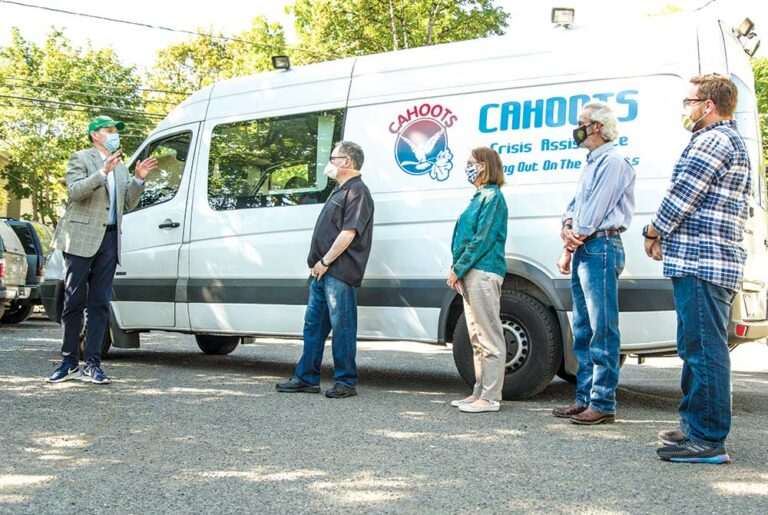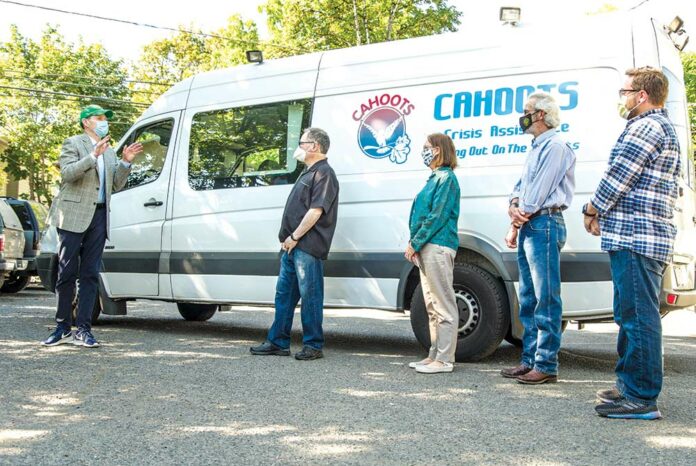By Chelsea Kurnick
In the wake of nationwide police-reform protests, North Bay activists are pushing governments to move funding from law enforcement agencies to other social programs, including increased investments in mental healthcare in an effort to offset law enforcement agencies’ workload and keep residents safe.
Partly inspired by activists’ pleas to reallocate funding from law enforcement budgets to preventative social services, two Sonoma County public meetings focused on mental health services last week. Similar discussions took place in Marin County in recent months, but, as in Sonoma County, politicians have not yet found extra funding and seem largely hesitant to take it from law enforcement agencies as some activists have suggested.
On Friday, Aug. 7, Santa Rosa’s recently-formed Public Safety Subcommittee met to discuss crisis response alternatives to armed police dispatch for calls concerning mental health and homeless people. On Tuesday, Aug. 4, the Sonoma County Board of Supervisors voted unanimously to put a measure on November ballots that would create a quarter-cent sales tax to fund local mental health, addiction and homeless services.
At their Aug. 7 meeting, the three members of Santa Rosa’s Public Safety Subcommittee—including Mayor Tom Schwedhelm—were enthusiastic about launching a program like Eugene, Oregon’s Crisis Assistance Helping Out On The Streets (CAHOOTS).
CAHOOTS dispatches teams of two, consisting of an EMT or nurse and a crisis worker with a mental health specialization—both unarmed—to calls for mental health support and other non-violent situations.
Santa Rosa Police Captain John Cregan gave a detailed presentation about CAHOOTS alongside other models of crisis response, including dispatching police officers in polo shirts and jeans, which Cregan says happens in San Antonio, TX. Cregan is also on the Board of Directors of National Alliance on Mental Illness (NAMI) Sonoma County.
CAHOOTS, which launched in 1989 through the nonprofit organization White Bird Clinic, is now a 24-hour service in Eugene and Springfield, Oregon, dispatched through the Eugene police-fire-ambulance communications center and Springfield’s non-emergency police number.
Cregan noted in his presentation that Eugene, which has a population of about 171,000, is a similarly-sized city to Santa Rosa. Eugene Police Department (EPD) received almost the same number of calls for service as Santa Rosa did in 2019, according to Cregan.
In 2018, CAHOOTS responded to nearly 23,000 calls, which accounted for almost 20 percent of EPD’s public safety call volume. Among other things, these calls might have included people experiencing psychosis, suicidal ideation and substance addiction, or people in need of shelter.
Not only does CAHOOTS offer an alternative to police response in these cases, the scope of CAHOOTS work goes beyond that which law enforcement officers provide.
Cregan said that some of CAHOOTS’ work is “out of the scope of the work of the police department or the fire department, but definitely provides a service to their community. So they’ll transport people to get their prescription drugs refilled. They’ll transport people to doctor’s appointments, they’ll even transport people, like, to Social Security.”
Calling these types of support an “upstream approach” to crises, Cregan echoed a sentiment expressed by NAMI Sonoma County Executive Director Mary-Frances Walsh.
“Crisis care is the most expensive form of care,” said Walsh. “We’re spending so much money at the most expensive levels of service, because people need it, obviously. But it’s taking away from the programs that could help avoid crises in the first place.”
Live public comments during the meeting were nearly all in support of Santa Rosa establishing a CAHOOTS-type program, many calling for it to be created by reallocating funds currently within the SRPD budget.
A community member named Jolie called for a more compassionate response to mental health crises, addiction and homelessness.
“I feel very emotional about this topic,” Jolie said. “I was a youth that struggled with drug addiction and was in programs and was a ward of the court. And now I’m sitting in city council meetings and trying to get you guys to see that … adding more money to the police and having them respond to mental health crisis calls and homelessness is not the way of our future.”
An educator named Melissa said, “We need to be supporting the folks in our communities, rather than punishing them—which is essentially what we are doing now. You are punished for being homeless, you are punished for having a mental health crisis.”
Although the current proposals in Sonoma County wouldn’t remove funding from law enforcement agencies—in the case of Santa Rosa, it seems that funding for a CAHOOTS-like program would go through the police department, possibly leading to a budget increase—the council’s discussion indicates renewed thought about a question raised by activists around the country. The core question: Are law enforcement officers best equipped to respond to calls related to a mental health crisis?
Activists who support defunding law enforcement tend to say no.
“Defunding the police moves in the direction of eliminating roles that police have taken on—like crisis mental health support—for which they are not experts and which could be done by trained people for less. So it is making budget decisions that reallocate funds to services like mental health and education instead of policing, and in that sense it certainly eliminates some of the work that police are doing,” Lisa Bennett, a representative of Showing up for Racial Justice’s Marin chapter, told the Marin Independent Journal in June.
Current Alternatives
Kelley Payne, a Santa Rosa resident, recently created a mini-zine called Who to call instead of 911: Sonoma County Resources for when you don’t want to call the cops. Payne was inspired by an image she saw in local activist groups online listing mostly national numbers to call instead of the police.
“Who to call instead of 911 is my offering to the community to not only help folks on the ground right now, but also to encourage the public to begin envisioning a world where calling the police is not the first course of action for non-emergency situations,” Payne said.
Payne’s zine presents dozens of wide-ranging resources, from mental health support phone lines to local food banks to domestic violence shelters. However, when it comes to critical mental health care needs, Payne finds that Sonoma County falls short of offering resources that don’t involve police. The zine notes, “Some police jurisdictions have something called the Mobile Support Team (MST) that is available certain hours to respond alongside police. They are clinicians who are much more skilled and trained to respond to mental health crises.”
Payne said, “Being able to receive help from a culturally competent agency or nonprofit, without the threat of arrest or (in some cases fatal) harm could be life changing for the Black, Brown and Indigenous communities in Sonoma County.”
The current annual budget for CAHOOTS is $1.16 million, which includes a fleet of vehicles that allows the team to transport clients. Santa Rosa Vice Mayor Victoria Fleming noted there is more demand for CAHOOTS’ services than their budget enables them to meet.
“I would love this program to be robust and to meet as many of the community’s needs as possible so that we can work toward de-escalation, demilitarization and decriminalization of things that are not actually criminal behavior,” Fleming said.
Mayor Schwedhelm said, “I’m at the point where we need to bring the CAHOOTS model to Santa Rosa. We don’t need to wait.”
Santa Rosa is not alone in looking to implement a CAHOOTS-like program. Denver launched its own version in 2019, and cities across the nation are considering similar pilot programs.
After visiting White Bird Clinic, Oregon Sen. Ron Wyden introduced a national CAHOOTS Act on Aug. 4, which would grant enhanced Medicaid funding to “help states adopt their own mobile crisis response models….”
Critically, the CAHOOTS Act stipulates, “Mobile crisis teams must not be operated by or affiliated with state or local law enforcement agencies, though teams may coordinate with law enforcement if appropriate.”
This is distinct from the model of Sonoma County’s current MST, mentioned in Payne’s zine. MST is a small team of mental health professionals whom law enforcement officers may call, if they choose, to a scene once the officers have deemed it secure.
Since its inception in 2012, MST has gradually expanded the geographical areas it serves and the police departments it partners with, yet budget cuts have also shortened its hours.
In Marin County, the Health and Human Services department operates the Mobile Crisis Team (MCT) which offers similar services to Sonoma’s MST. However, historically, Marin County’s crisis response program has not had much funding either.
According to the Point Reyes Light, staff at Marin’s MCT received an average of 35 calls and responded 18 times each week this May. And, although the county received a one-year state grant to boost the program, MCT will still only have a minute fraction of the capacity of local law enforcement agencies.
Today, Sonoma’s MST has offices in Petaluma, Santa Rosa and Guerneville. Its coverage boundaries extend from Petaluma in the south to Windsor in the north and Sonoma in the east to much of West County. Though it does not have an official partnership with Healdsburg or Cloverdale Police, MST Director Karin Sellite says the team has occasionally been called upon for support in these jurisdictions.
When asked if there is a plan to make MST available 24 hours a day, seven days a week, Sellite said, “We would love to. There’s a desire for it in the community, certainly. We don’t have the budget to be 24/7. We could certainly be, if we had the funding.”
Sellite explained that MST used to be in Santa Rosa and Windsor seven days a week from 2pm until midnight. Then, around 2015, a shift in funding required them to cut their hours back. Presently, MST works from 1–9pm Monday through Friday, but their phones are only on between 1:30pm and 8:30pm, and with no overtime budget, a request toward the end of the shift may not allow time for MST to respond to the call.
In his presentation to Santa Rosa City Council subcommittee, Cregan noted that SRPD utilized MST on 137 calls in the 2018 fiscal year and 101 calls in the 2019 fiscal year, 0.07 percent of the 137,690 calls for service the department says it responded to in calendar year 2019.
While someone calling 911 may request that they would like MST to be dispatched right then, police go to the scene first and decide whether they feel MST will be helpful.
In the worst situations, the difference between dispatching a mental health professional and a law enforcement officer can have lethal consequences if an officer responds to a person’s mental breakdown with force, instead of successfully deescalating the situation.
“Although we have really excellent working relationships with all of the law enforcement entities that we work with, there are individual officers who just love us and they call us all the time—and there are probably officers who don’t really get it and just don’t call us,” Sellite says.
Sellite says that, just before Covid-19 began, MST was starting to pilot with West County Community Health Center to allow the health centers to call them directly rather than going through law enforcement first.
If the quarter-cent Sonoma County tax passes in November, it will generate an estimated $25 million dollars annually, some of which will support the chronically underfunded MST, according to Leah Benz, Sonoma County Program Planning & Evaluation Analyst.
County polling indicates strong support for the measure—greater than 70 percent support in a recent survey of 615 likely voters throughout the county. That said, it will need two-thirds support to pass, which is a substantial hurdle.
Three groups of North Bay business leaders—North Bay Leadership Council, North Coast Builders Exchange and Sonoma County Farm Bureau—have voiced opposition to all proposed tax increases until 2022, citing economic concerns amidst the pandemic.
Supervisor Lynda Hopkins expressed concerns about funded opposition to the measure and said that the county should be thinking about a Plan B to ensure the county’s Behavioral Health programs can be secured and expanded.
How the money would be used is already largely determined.
“The goal of the expenditure plan is to protect programs that are in jeopardy and expand needed services,” Benz said.
By Chelsea Kurnick













